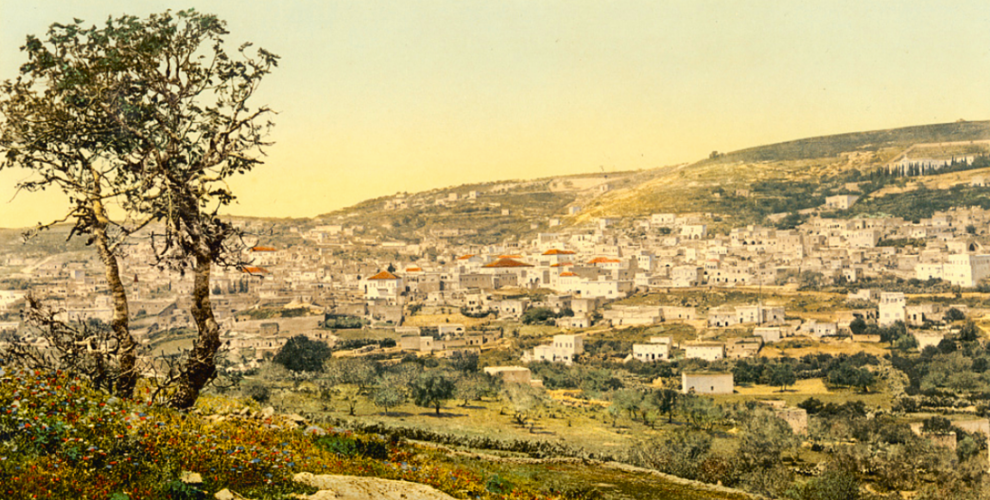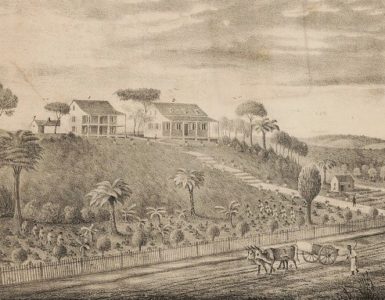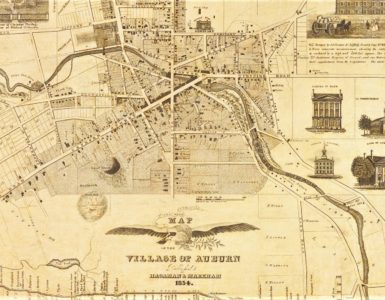Why was Jesus born the son of a carpenter, to work as a carpenter (Mt 13:55; Mk 6:3)? Some would respond that before the Son of God entered his public ministry he needed to work, and carpentry provided a living as good as any other. However, there are other occupations which look as if they would have been better suited to prepare him for ministry. Fishing would have been fitting work; Jesus called the disciples to become fishers of men, fed multitudes with fish and bread, and compared the kingdom of heaven to a fishing net. He could have been a vintner, growing and processing grapes for wine. Young Jesus turned water into wine, then later said he himself was the vine feeding his disciples, and he cautioned his listeners against putting new vintage into old skins. Shepherding could be called a family tradition, since the Messiah came from the line of Judah, and King David worked among the sheep. Jesus told a parable about seeking the lost lamb, he said he knows his sheep, and—most importantly—he is the sacrificial Lamb of God. Shepherding would seem a better occupation than carpentry.
Christ did not say much about wood or carpentry. He spoke of judging others with the analogy of the eyes having a splinter or a log, and he alluded to carpentry when he told of the man tearing down barns to build bigger ones. Why the Christ was born of the virgin Mary into a carpenter’s household is information the Lord has not condescended to reveal to his image bearers. However, this brief article proposes that the attributes of carpentry uniquely contributed to prepare Christ for his earthly ministry.
When I was a child visiting my grandparents a man I did not recognize came to the house. My grandmother introduced him to me as her brother. He was a quiet and reserved man, but he none the less extended his hand in gentlemanly fashion and I grasped it. I could feel his calloused leather-like palm and fingers. I was surprised by the texture and lack of suppleness of the skin. Grandmother informed me that her brother had been a carpenter for a number of years. The manual procedures required for his trade had resulted in gloves of skin created by reoccurring contact with the rough surface of wood.
Like my great uncle, the Lord of Glory’s hands had been thickened to some degree over time by tooling wood. Some of the personal encounters Jesus experienced during his ministry might raise a question regarding God’s wisdom in selecting carpentry for a trade. Consider some of the things Jesus did in ministry. His thick-skinned fingers took mud he made from spittle and dirt and gently applied it to the eyes of a blind man to give him sight (Jn 9:6). It was his toughened hands that gently touched the children that came to see him (Mt 19:13-15). Then, following rash Peter’s slash of Malchus’s ear with a sword, the Christ, the anointed one, carefully used his calloused hand to miraculously restore the ear (Jn 18:10; Mt 26:51). The softer hands of a physician, lawyer, or scholar may be thought more appropriate for Jesus’s work, but the toughened hands of the Carpenter exemplified his full humanity as he accomplished the divine work of redemption.
Jesus often argued from the lesser to the greater in his teaching, but his carpenter’s hands show a physical argument from the intuitive, what man expects, to the counterintuitive, what God does. The ways of the Triune God are not man’s ways. Christ’s hands exhibited his mannishness—and their skill came in handy to make a whip for running the moneychangers out of the temple—but those same hands could also minister gently when needed.
There is another aspect of wood working that contributed to prepare Jesus for his ministry: Patience learned through temptation and persistence. Without patience, working wood is an exercise in frustration, leading to temptation through anger which, if yielded to, becomes sin. When tooling any species of wood, the wood’s characteristics govern the success of the project. A carpenter must study the tightness of grain in a board, the hardness of the piece, how wet it is, the location of any knots, and the color patterns to ascertain the best way to cut, chisel, or plane it. An open grain wood such as oak characteristically chips and splinters easily, while other woods such as walnut and mahogany can vary in their grain patterns significantly from board to board.
Wood working techniques in Jesus’s day were not as sophisticated as today, but the nature of wood still offered challenges and the tools for overcoming them were primitive. Cutting wood tests patience and even the finest cabinet maker may find a nearly completed masterpiece turned to scrap with a wayward cut or a mismeasurement. When Christians contemplate Christ’s temptations, they often think of the lofty enticements from Satan in the wilderness, or the agony in Gethsemane as Jesus faced the cross. Yet the simple hazards of the carpenter’s shop and daily living tempted the Lord of Glory as well. Hebrews 4:15 is a verse of comfort for the Christian, because it says Jesus, the Great High Priest, was tempted thoroughly yet did not sin. In his comments on the verse, Richard D. Phillips points out that the Lord’s compassion is founded in his experience with temptation:
The Lord you serve, the Savior to whom you look, is not aloof from your trials, but feels them with intimate acquaintance. He is not disinterested or cold to what you are going through; he came to this earth and took up our human nature precisely so that he might now be able to have a fellow feeling with us (P&R, 2006).
Two points are to be noted. First, Christ took up our human nature precisely, that is, he was and is fully man, and was tempted not only in the wilderness by Satan, but also during the day-to-day events of life—including carpentry. Secondly, Jesus is seated at the right hand of the Father and he has a fellow feeling with us. What an alliterative and pleasing way of expressing the Son’s compassion.
In some corporations today, executives are required to work for a time in some of the jobs occupied by their employees, giving them a sense of what their workers have to deal with. Christ knows and understands his children’s trials because he has experienced them himself. Earthly heirs to political kingdoms have often grown up as princes and princesses in protective cocoons shielding them from commoners. A king or queen rarely enjoyed friendship or contact with their subjects, but King Jesus knows what it is like to live in this world; his empathy is not artificial or contrived, but is instead based on experience.
Jesus’s patience had been put to the test for the thirty years leading up to his public ministry. When he called the twelve and taught them the ways of the Kingdom of God, his patience was tested in new ways. The disciples jostled for the head of the table competing among themselves; impulsive Peter offered some challenges when he shot from the hip in dialogue with the Master; and then there were the disciples that did not stay awake and pray in Gethsemane as the Lord had instructed them. Jesus’s life was a test of forbearance and carpentry contributed to teaching him patience.
When Jesus was arrested, the events leading to crucifixion began. Following the scourging, beating, mocking, and forcing of the crown of thorns upon Christ’s head as the Romans and onlookers cursed him, he made the journey to Golgotha to be crucified. As the bleeding and exhausted Messiah struggled along the route, he carried the beam that would be placed on the stanchion permanently set in the ground for crucifixion. The beam borne by his wounded and bleeding shoulders increased his pain and weakness such that Simon of Cyrene was compelled to carry it. Once at the place of crucifixion, the Messiah, the Christ, the Son of God was nailed to the cross. Jesus hung from the beam in agony as it was hoisted and mounted to the stanchion. He felt the roughness of the cross. Wood was a familiar material for Jesus. He learned how to use wood and respect it, but now the familiar material he tooled while working with Joseph became the instrument of his death. As the Scripture tells us, just before Jesus died, he said, “It is finished!” (John 20:50). In his commentary on the Gospel of John, Leon Morris summed up what it was that Jesus finished: “He had taught and he had healed and he had set the example in his own life, and now he gave his life ‘a ransom for many’” (Eerdmans, 1992, p. 723).
Jesus the carpenter and son of a carpenter had died on a cross made by a carpenter.
Why was Jesus born the son of a carpenter to work as a carpenter? The question remains answered only in the mind of God. Yet it can be said that the Father’s plan to atone for sin through Christ was perfect, and carpentry provided the perfect home life and work for the Son of God who would take away the sins of his people.
Barry Waugh
Notes–The header is snipped from a print available on the Library of Congress site titled, “From the east, Nazareth, Holy Land,” dated ca. 1890 to ca. 1900, and published by the Detroit Photographic Company, 1905. “The Carpenter and the Cross,” was first published April 9, 2020 on the Alliance of Confessing Evangelicals site Ref 21; my posts on that site are listed on this site at “On Reformation 21.”
Opinions vary as to whether Joseph was a carpenter in the sense of actually working wood. An article by Ken M. Campbell, “What was Jesus’ Occupation,” Journal of the Evangelical Theological Society 48:3 (September 2006), 501-519, posits that Jesus was more of a general contractor and less hands-on in his work. Others say the word translated “carpenter,” τέκτων, could be used to describe other trades, specifically pottery, metal working, or even trades in general. In this article I used the word carpenter in its most general sense, including trades we see today such as jointer (finish carpenter), cabinet maker, framer, and other occupations which use wood for their primary raw material for construction. It is an old commentary but still helpful, see William Hendriksen on the Gospel of Mark (p. 222) regarding the Matthew and Mark passages speaking of carpentry and Jesus. Hendriksen refers to Justin Martyr’s comment that Jesus made yokes and plows, which means he would have used sharp edged tools to contour wood.
A question I have about the cross is, how was the cross beam affixed to the stanchion? Note here that I believe the cross was shaped like an upper-case T rather than a lower case one. The sign describing Jesus’s supposed crime would have been nailed to one of the two vertical side surfaces of the cross beam so that it protruded above his head. The few publications that I have read about the construction of the cross are ambiguous about how the connection between the cross beam and stanchion was made. Probably further reading would answer the question, but I am guessing that the exposed end of the stanchion was tenoned. The tenon was fitted into a mortise at the center of the cross beam (some sources say the word “cross” refers only to the horizontal beam). Thus, the victim of crucifixion was put in position by sliding the loose-fitting mortise over the tenon of the stanchion. My guess is that the tenon would have been lubricated with animal fat to ease installation of the cross beam. When the victim was dead, the body and cross beam could be removed easily to allow for the next execution. The Romans would have found this design efficient for the horrible executions they so often practiced.





